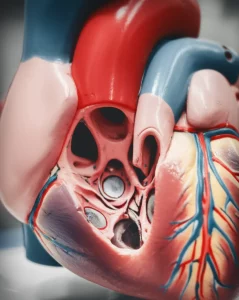A Rare Heart Hiccup After a Minimally Invasive Fix
Okay, so let’s talk about fixing leaky or stiff heart valves, specifically the aortic one. For folks who aren’t quite up for open-heart surgery – maybe they’re a bit older or have other health stuff going on – there’s this fantastic procedure called TAVI, or Transcatheter Aortic Valve Implantation. It’s pretty neat because it’s minimally invasive, meaning less cutting and usually a quicker bounce-back time.
Now, TAVI isn’t a one-size-fits-all deal when it comes to *how* you get the new valve into place. There are a few routes we can take: the common one is through the leg artery (transfemoral), but sometimes we have to get a bit creative and use the armpit (transaxillary), directly through the aorta (transaortic), or even, yes, through the tip of the heart itself (transapical). This last one, the transapical approach, is less common these days and usually only used when the other paths are blocked or just not suitable.
An Unexpected Turn
Imagine this: We had this gentleman, 87 years young, who had quite a history. He had some serious issues with his arteries, not just in his legs but even up in his neck. On top of that, he’d had a heart attack a while back, needed a stent, and that stent even got blocked again, requiring another fix with a balloon.
Given his tangled-up arteries, the usual TAVI routes were a no-go. So, about four years ago, we opted for the transapical approach. It involves a small cut in the chest to get directly to the heart’s apex (the tip) and put the new valve in. He got his new valve, an Edwards Sapien 3 Ultra, and for a good four years, he was doing pretty well, mostly breathing easy.
Something Shows Up
Then, four years down the line, he had a fainting spell and came to see us. We did an echocardiogram – that’s like a sonogram for the heart – and saw something unexpected. Right at the tip of his left ventricle, where we’d gone in for the TAVI, there was this weird, rounded image. It had bright, defined edges but was empty inside. Hmm, definitely not something you want to see.
To get a clearer look, we followed up with a CT scan. This confirmed our suspicion – there was indeed a round structure near the heart’s apex, right where the transapical access had been. It looked like it was probably related to the previous procedure. But the real clincher was a PET-CT scan. This fancy scan uses a special tracer that highlights metabolic activity. The structure near the apex lit up with a ring-shaped pattern, which is pretty suggestive of inflammation or activity around a collection.
Based on all these images, we diagnosed him with a cardiac apex aneurysm, or more accurately, a pseudoaneurysm (a false aneurysm where the wall isn’t made of normal heart muscle). It looked like a direct result of the transapical TAVI procedure he’d had years before.

Why This Matters
Now, while TAVI is generally safe, especially the transfemoral route, any procedure has potential hiccups. The transapical approach, because it involves directly accessing the heart muscle, has its own set of unique risks. We know about things like bleeding or issues with the aorta, but a pseudoaneurysm at the access site? That’s pretty rare.
We looked through the medical literature, and while left ventricular pseudoaneurysms *do* happen, seeing one specifically linked to a transapical TAVI access site isn’t something you find reports on every other day. A few cases have been described, often, like our patient, in older folks.
There’s even a bit of a debate in the medical community: is this finding a direct complication of the TAVI access, or could it be something else entirely, perhaps just showing up in a vulnerable heart? It’s a fair question, and this case certainly adds fuel to that discussion.
The Big Takeaway
Regardless of the exact mechanics, this case really drives home a few crucial points. When we’re deciding the best way to do a TAVI, especially for patients with complex medical histories or tricky anatomy that forces us to use alternative routes like the transapical one, we need to be incredibly thorough in our initial assessment and planning. It’s not just about getting the valve in; it’s about anticipating potential issues down the road.
And perhaps even more importantly, this highlights the need for long-term follow-up. Even years after a seemingly successful procedure, rare but significant complications can pop up. We need to keep an eye out for things like ventricular pseudoaneurysms, especially in patients who had these less common access routes.
Ultimately, it’s all about making the best, most individualized plan for each patient and staying vigilant, because even with minimally invasive procedures, the heart can sometimes throw us a curveball.
Source: Springer







